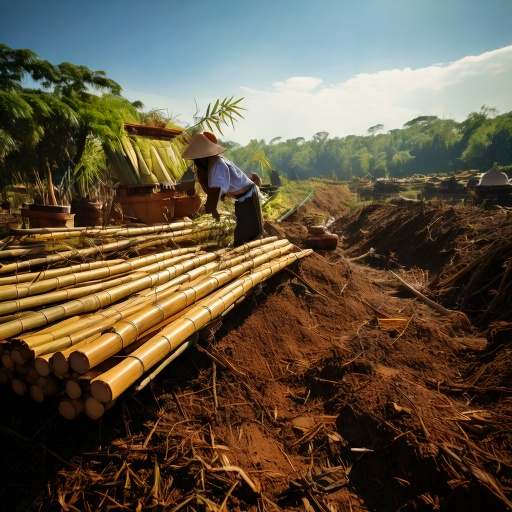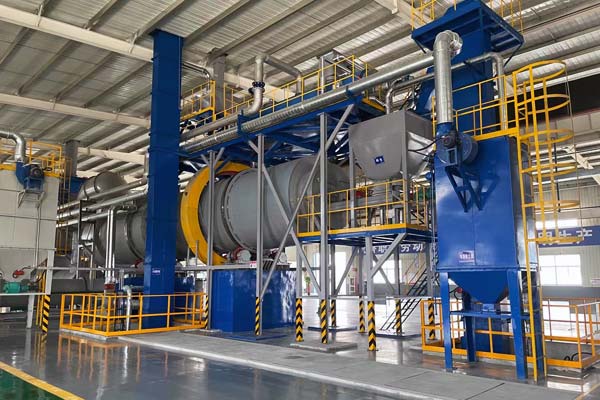Biomass – Waste Pyrolysis: Multi-Product Revenue Streams
Waste Pyrolysis is a high-efficiency thermal process that acts as a flexible biorefinery, converting agricultural residue into three distinct, high-value outputs: Bio-oil, Biochar, and Syngas.
This step reinforces the Zero Waste principle of the Ecoladang Ecosystem by offering dynamic control over the output mix. Depending on market demand, we can adjust the pyrolysis parameters to maximize the production of either solid carbon (Biochar) or liquid fuel/chemical precursors (Bio-oil), ensuring optimal economic returns at all times.
This step reinforces the Zero Waste principle of the Ecoladang Ecosystem by offering dynamic control over the output mix. Depending on market demand, we can adjust the pyrolysis parameters to maximize the production of either solid carbon (Biochar) or liquid fuel/chemical precursors (Bio-oil), ensuring optimal economic returns at all times.
The Pyrolysis Process: Controlled Thermal Decomposition
Pyrolysis is the thermal decomposition of biomass occurring in the complete absence of oxygen. The temperature and speed of heating dictate the final product distribution.
The Flexible Conversion
- Input Feedstock: Dried and prepared agricultural residue (identical to the input for Gasification and Carbonization) is fed into a sealed reactor.
- Rapid Heating:The biomass is heated rapidly to high temperatures (typically 300C to 650C.
- Vaporization: Without oxygen, the organic compounds in the biomass vaporize into hot gases and vapors.
- Output Separation:The vapors are rapidly cooled (condensed) to produce Bio-oil. The remaining non-condensable gases are Syngas, and the solid residue is Biochar.

The Ecoladang system leverages the following modes based on strategic goals:
- The EcoladanFast Pyrolysis (Primary Focus):Optimized for producing the highest volume of Bio-oil (typically 60-75% liquid yield). This dark, viscous liquid can be refined for sustainable fuels, specialty chemicals, or as a boiler fuel.
- Slow Pyrolysis (See Carbonization):Optimized for producing high volumes of Biochar (solid carbon yield), which is covered in detail in the Biomass Carbonization section.g system leverages the following modes based on strategic goals:
Pyrolysis delivers a sophisticated income portfolio, offering three simultaneous products from a single waste stream:
Produced primarily via Fast Pyrolysis, Bio-oil is a renewable, high-energy-density liquid. It can be used directly as a sustainable energy source or fractionated into valuable platform chemicals for industrial markets.
The solid carbon byproduct, Biochar, remains crucial for soil amendment, carbon sequestration, and as the precursor material for Activated Carbon Production (Pillar 4).
All pyrolysis processes generate non-condensable Syngas (CO, H2, CH4). This gas is immediately combusted in-situ to provide the thermal energy required to power the pyrolysis reactor itself. This makes the entire operation highly energy-efficient and self-sustaining, reducing external energy costs.

Diversified Income Portfolio
Generates income from liquid (Bio-oil), solid (Biochar), and internal energy (Syngas) products. - Mitigates market risk by reducing reliance on a single commodity (e.g., only Biochar or only energy).
Thermal Self-Sufficiency
The Syngas byproduct is recycled instantly to fuel the reactor's heating needs. - Ensures the Pyrolysis unit operates with minimal external energy input, boosting profitability.
Chemical Feedstock Source
Bio-oil offers a non-petroleum source for specialty chemicals and advanced biofuels. - Positions Ecoladang to participate in the high-growth green chemistry market for higher margins.
Environmental Cleanup
Efficiently processes residual agricultural waste that would otherwise decompose or be openly burned. Eliminates farm waste liability and avoids associated $\text{GHG}$ emissions, furthering sustainability goals.
Core Infrastructure
The entire gasification unit is integrated with the PCDS (Pillar 2) where the AI models and software services optimize feedstock rates, gas quality, and power output in real-time. This digital integration maximizes fuel conversion efficiency and ensures stable 400V power delivery precisely when and where it is needed.
The next stage in this pillar, Biomass Carbonization, takes the solid output from this process and turns it into our first high-value commercial and agricultural product. Do you want to review and expand that page next?